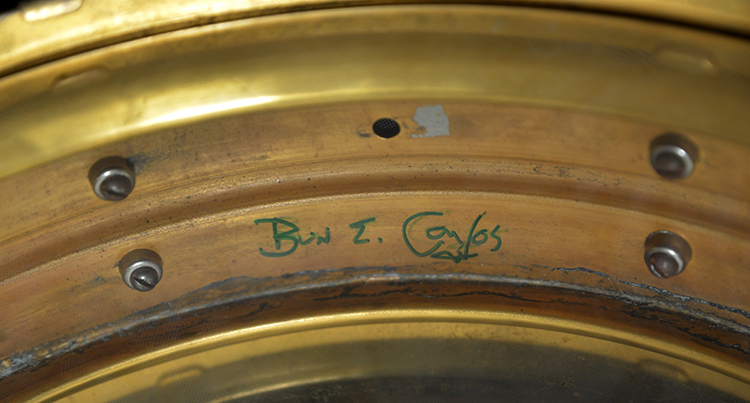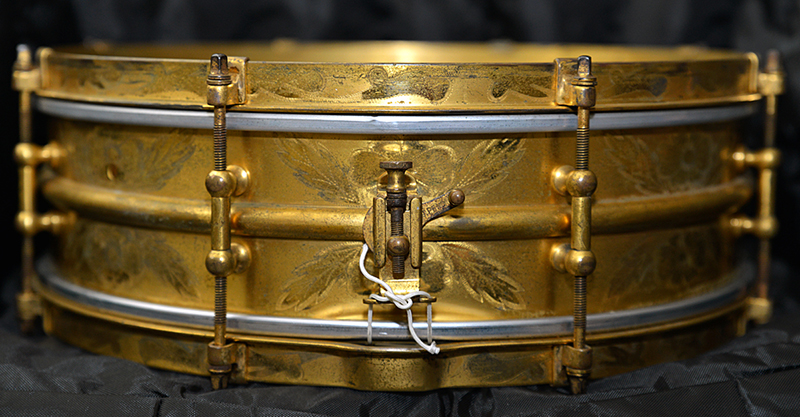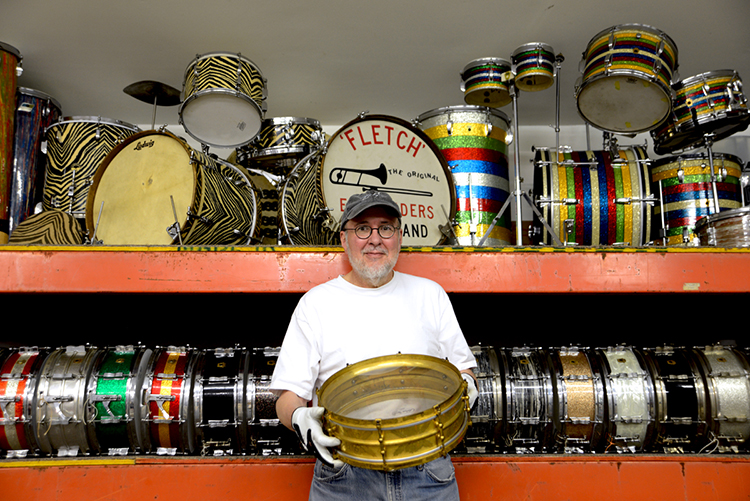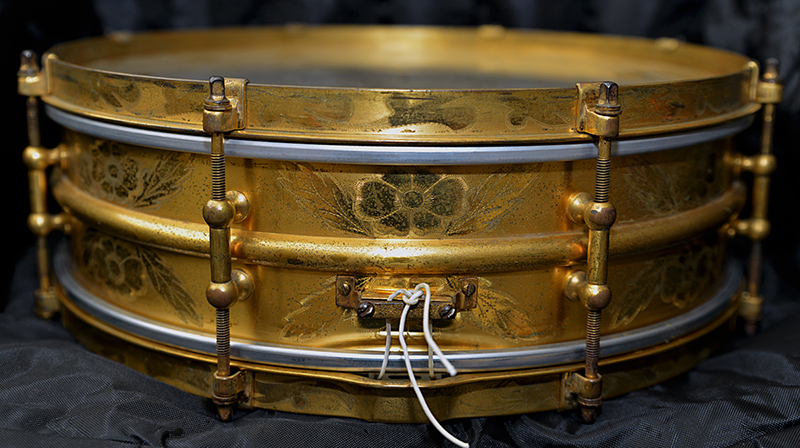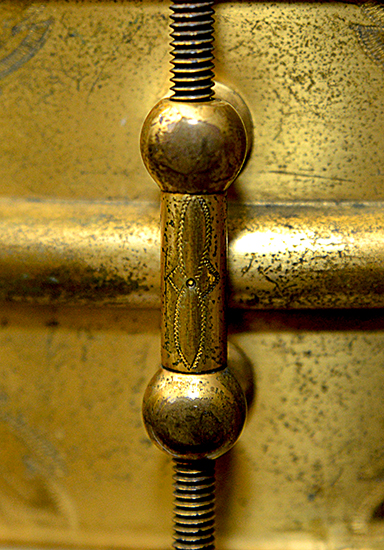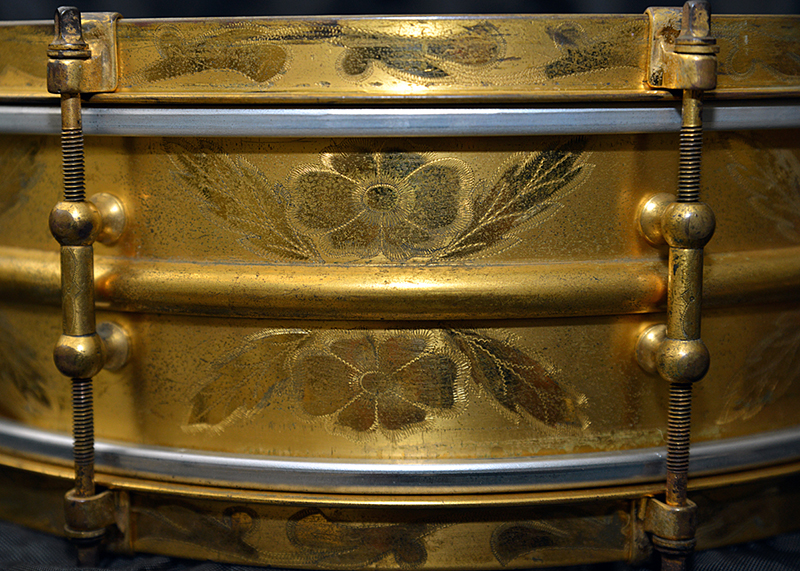This drum is definitely a 1920s Ludwig & Ludwig gold plated /engraved Triumphal Model. I did notice a few minor differences as compared to my Triumphal... 1. This drum has a 5-petal rose engraving as compared to my drum that has a 6-petal rose engraving... 2. This drum has the “Ludwig Chicago” in the same panel as the P-338 strainer as compared to my drum where the “Ludwig Chicago” is located 2 panels to the left of the strainer. Nothing earth shattering but interesting enough for me to pursue it further, ergo; was this a different engraver than my drum?
Read moreBob Campbell's 1920s Ludwig & Ludwig Wild Rose Triumphal
The Robert M. Campbell Collection - “1920’s Ludwig & Ludwig 4 X 14” Wild Rose pattern engraved, gold-plated Triumphal, Standard Model” - by Robert “Bob” Campbell
As a collector, there are those “holy grail” or “desert island” snares that you hope one day to find, and with some good luck and sufficient cash, possibly own. At the 2013 Chicago Drum Show, I had the good fortune to be seated next to Bun E. Carlos during the filming of a Vintage Drums Talk segment by Jim Messina, www.vintagedrumstalk.com, www.youtube.com/watch?v=YrOuznVG2ZU). I’m not sure how the conversation started but Bun E. began telling me some stories about the legendary Charlie Donnelly (Connecticut drum store owner and vintage drum expert who Steve Maxwell credits as “the person responsible for jump-starting me down the path of vintage drums.”) This progressed to talk of our collections. I mentioned that I had purchased a Ludwig 1928 Gold Triumphal 100th Anniversary Reissue from Steve Maxwell. However, I said, “I really wanted an original 1920’s Ludwig & Ludwig Triumphal.”
To my surprise, Bun E. said something like, “I have one that I might sell. Are you seriously interested?” I, of course, replied with a most eloquent answer, “Umm, really?” So then and there, we made a deal.
Bun E. kindly invited me to pick up the drum at his storage barn. His amazing, expansive collection is a story for another time but I did get the Triumphal, signed by Bun E. on the inside of the shell.
I was very curious about the history of the drum and asked Bun E. for some background information. He referred me to Steve Maxwell, who originally acquired this Ludwig & Ludwig Triumphal. Steve said the fellow who had the drum obtained it in Chicago from his teacher in the 1950’s. He didn’t play it much then because it was “so nice”. When the seller contacted Steve, he hadn't played in 20 years and wanted to see how much it was worth. Steve provided this interesting account of how this unique, historic drum serendipitously came into his shop:
“I get a call out of the blue from a guy who says he has a metal Ludwig rare drum and since he's in his 70s and living on social security he figures he might as well try to sell it and see if it's worth a few dollars. I asked him to describe it and he told me it was a 1920’s Ludwig. He thinks it's a 5", then again maybe a 4x14”; and he said it was engraved. So, I assume he's talking about a regular Black Beauty, so I ask if the shell is black with engraving showing through, and he says, "No, it's a gold color". So, now I figure that he's got a stripped shell that was originally an engraved black beauty since we see that sort of thing from time to time, and therefore value is a lot lower. So, I ask him about the engraving pattern and if it is floral (and I describe the typical 10-point and 12-point floral) and he says "no". So I describe the typical scroll pattern and again he says "no". So I ask him what the pattern looks like and he says, "it's sort of like a flower". Now, the LAST thing I am thinking is that this might be another Wild Rose pattern Triumphal. I simply figure that he has a 1920’s era Standard that may have been nickel over brass, non-engraved; and I figure someone stripped it, polished the shell, and did a home-made engraving job. So, I tell the fellow to bring it in and I'll have a look. In the back of my mind, I'm thinking that this is maybe a $500-$700 player's drum. However, I didn't say that because I didn't want to disappoint him. So I figured I should just keep quiet until I actually saw the drum.
About a week later, he comes into my store with a drum case. I opened the case and just about passed out on the spot! Looking up from the case was an absolutely incredible 4x14” 1920’s era Wild Rose pattern Ludwig Triumphal. I told the guy to sit down because we had to have a serious talk here...
I pulled out Mike Curotto's book (Vintage Snare Drums: The Curotto Collection, Volume I) and turned to the page where Mike describes his Wild Rose, the only one that ever surfaced. I tell the guy that his drum is now only the second one in this pattern that has surfaced, and in fact is now the 8th Triumphal since only 7 other examples overall are known to exist.
As I mentioned in an email to Bun E, I could have bought this drum from the guy for a song since he needed cash, but I encouraged him to let me broker it on consignment so that he'd get a significantly higher amount than if I were to buy it outright. I told him that I felt we could move the drum fairly quickly for him. Then I told him what I thought we could get for the drum, and he almost passed out! He agreed to consignment so I then contacted Bun E and a few other people who I knew would be interested. Bun E grabbed it immediately. I delivered it to him in person, and the rest is history. It was a nice deal all around because the transaction was really life changing for the seller, and the drum went to someone who appreciated it (Bun E.), and now it's in your hands, which is great.” Many thanks to Steve for providing this wonderful story… Now if I could only find out who was the original owner prior to the 1950’s!
I am an avid believer that our drum history needs to be preserved and handed down to the next generation before it is lost forever. I am merely the custodian of this drum until it passes to the next owner. While I could not get the exact provenance of this Triumphal, I have captured all that I know in this article. If anyone has any information about the origins of this drum (or questions), please feel free to contact me at fallendrummer@me.com.
Brief background on the Ludwig and Ludwig Triumphal snare drum:
The Ludwig & Ludwig Triumphal snare drums were truly exceptional in their day, coincidentally only a few years before the great Stock Market crash of 1929 (e.g., 1925-1928). They were the pinnacle of drum making; gold-plated and ornately hand-engraved on the shell, hoops and even the lugs. My drum is indeed a 4 X14”, 8-lug gold-plated, engraved Ludwig & Ludwig Triumphal Standard Model with the Wild Rose pattern. The center-beaded, two-piece soldered shell is quite heavy for a 4 X14” (although I guess not atypical for brass shell drums of the period). As noted by John Aldridge in his “Guide to Vintage Drums”, the Triumphal like Black Beauties of the period had an air chamber inside the bearing edge, i.e., formed by bending back the last ½ inch of bearing edge at a 90 degree angle and soldering it to the shell. Upon close inspection, I did not find a weld so assume this is a spun brass shell. To date, it is only the second known to exist with the Wild Rose pattern and perhaps only 1 of 8 total Triumphals that have survived.
Acknowledgements: Many thanks to Steve Maxwell, Bun E. Carlos and Mike Curotto for all the input, encouragement and shared wisdom.

